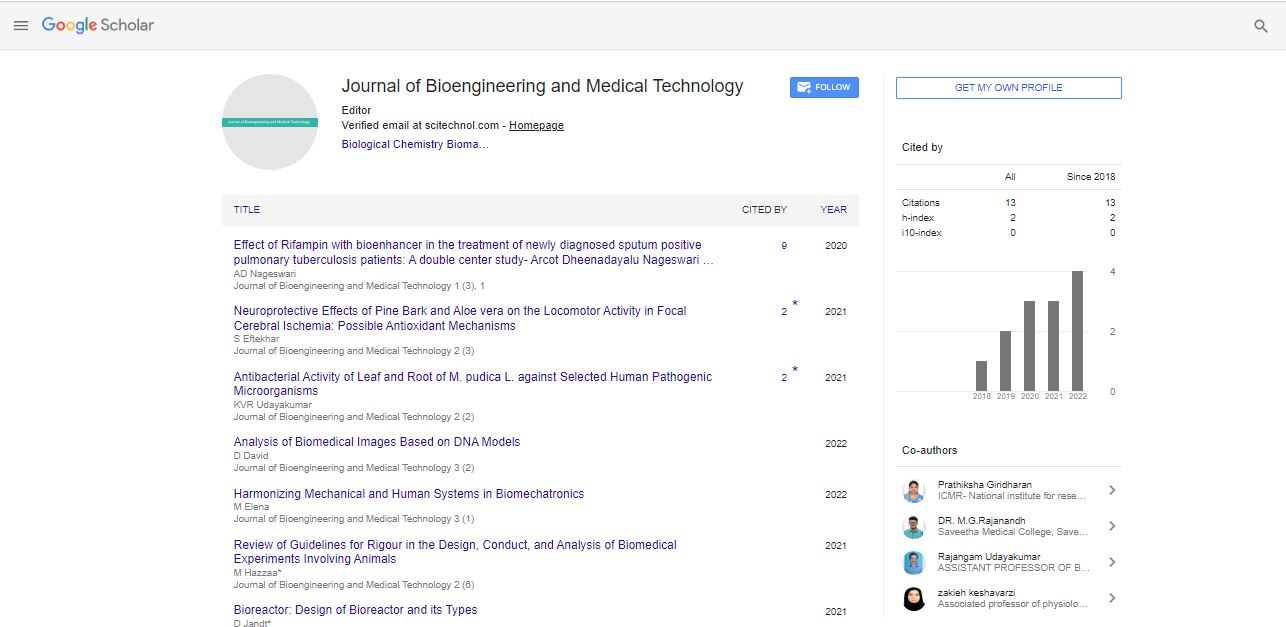Perspective, J Bioeng Med Technol Vol: 4 Issue: 1
Biomechanical Analysis of Human Movement: From Basic Principles to Clinical Applications
Shahil Modan*
Department of Biomechanics, Harper Adams University, Shropshire, UK
*Corresponding Author: Shahil Modan
Department of Biomechanics, Harper
Adams University, Shropshire, UK
E-mail: modanshahil@yahoo.com
Received date: 22 February, 2023, Manuscript No. JBMT-23-96000;
Editor assigned date: 27 February, 2023, Pre QC No. JBMT-23-96000(PQ);
Reviewed date: 14 March, 2023, QC No. JBMT-23-96000;
Revised date: 21 March, 2023, Manuscript No: JBMT-23-96000(R);
Published date: 28 March, 2023, DOI: 10.35248/jbmt.1000066
Citation: Modan S (2023) Biomechanical Analysis of Human Movement: From Basic Principles to Clinical Applications. J Bioeng Med Technol 4:1.
Description
Biomechanical analysis of human movement is a branch of science that studies the mechanical principles of human motion. It encompasses a wide range of applications, from understanding basic principles of movement to clinical applications in injury rehabilitation and prevention. Biomechanical analysis of human movement has significant implications in the fields of sports science, physical therapy, orthopedics, and many other areas of healthcare. The basic principles of biomechanics involve the study of human movement in terms of its mechanical components. These components include force, motion, and torque. The study of these components provides insights into how the body moves, how it generates force, and how it distributes that force across different parts of the body. Biomechanical analysis of human movement involves measuring and analyzing the motion and forces involved in various activities, such as walking, running, jumping, and throwing. One application of biomechanical analysis of human movement is in sports science. Understanding the mechanics of human movement can help athletes optimize their performance and prevent injuries. For example, biomechanical analysis can be used to identify the most efficient way to perform a certain movement. It can also be used identify the movements that put an athlete at a higher risk of injury, such as improper landing technique in jumping or improper throwing mechanics in baseball.
Another application of biomechanical analysis is in physical therapy and rehabilitation. Biomechanical analysis can be used to identify the specific movements that are causing pain or discomfort in a patient, and to develop customized treatment plans to correct those movements. For example, a patient with a knee injury may be analyzed for walking and running patterns to identify any mechanical issues that may be causing the injury. Then, a physical therapist can develop an exercise program to strengthen the affected muscles and correct the mechanical issues. The use of biomechanical analysis in clinical applications is becoming increasingly common. In orthopedics, biomechanical analysis is used to study the mechanics of joints and bones, and to develop treatments for conditions such as arthritis and osteoporosis. In prosthetics, biomechanical analysis is used to design and develop artificial limbs that mimic the mechanics of natural limbs as closely as possible. This allows patients to move more naturally and comfortably, and to perform a wider range of activities. One of the key tools used in biomechanical analysis of human movement is motion capture technology. This technology uses cameras and sensors to record the movement of the body during various activities. The data collected can then be analyzed to determine the forces and motions involved in the activity. This technology has become increasingly sophisticated in recent years, allowing for more detailed and accurate analysis of human movement. In addition to motion capture technology, other tools used in biomechanical analysis of human movement include force plates, Electromyography (EMG) sensors, and computer simulation software. Force plates are used to measure the forces generated by the body during various activities, such as jumping or landing. EMG sensors are used to measure the electrical activity of muscles during movement, providing insights into muscle function and activity. Computer simulation software is used to model and analyze human movement, allowing researchers to simulate different scenarios and test different hypotheses.
In conclusion, biomechanical analysis of human movement is a rapidly evolving field with many applications in healthcare and sports science. Understanding the mechanics of human movement can help athletes optimize their performance and prevent injuries, and can help healthcare professionals develop customize treatment plans for patients. Biomechanical analysis is becoming increasingly sophisticated, with the use of motion capture technology, force plates, EMG sensors, and computer simulation software. As technology continues to advance, the insights gained from biomechanical analysis will become even more valuable in understanding and improving human movement.
 Spanish
Spanish  Chinese
Chinese  Russian
Russian  German
German  French
French  Japanese
Japanese  Portuguese
Portuguese  Hindi
Hindi 
